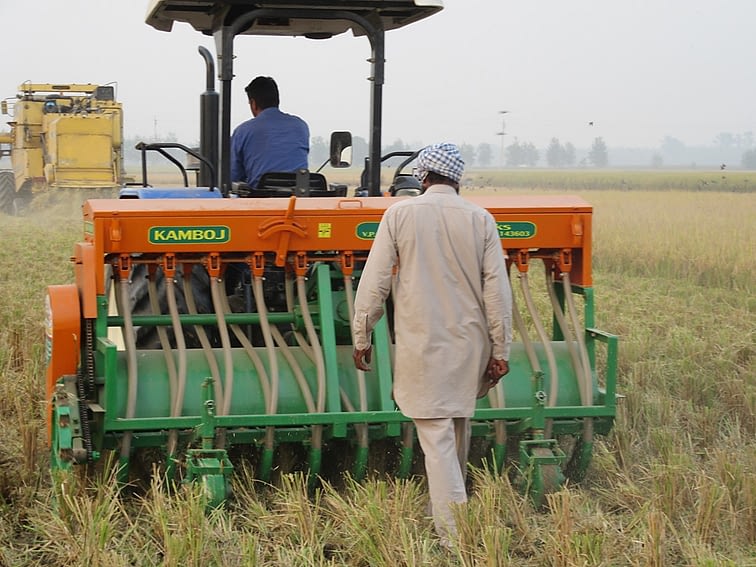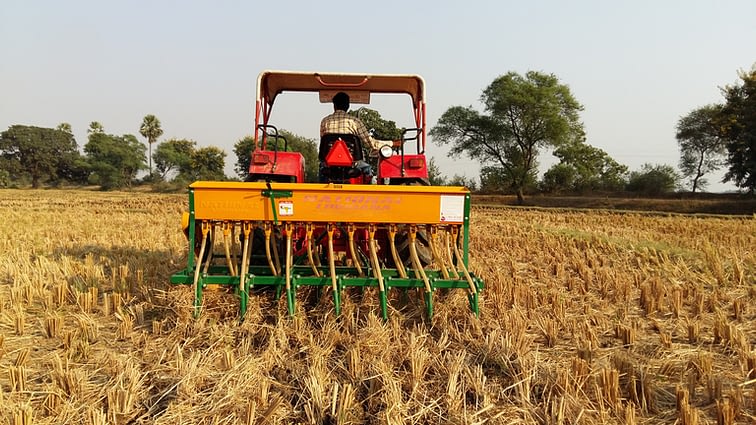“Happy Seeder” saves farmers money over burning straw, new study in India shows
Authors conclude that no-till, no-burn practices can cut severe pollution in northern India and that they merit strong policy support, including enforcement of bans on burning straw.
The original version of this story by Mike Listman can be found on the International Maize and Wheat Improvement Center (CIMMYT) website.

Compared to conventional tillage practices, sowing wheat directly into just-harvested rice fields without burning or removing straw or other residues will not only reduce pollution in New Delhi and other parts of northern India, but will save over $130 per hectare in farmer expenses, lessen irrigation needs by as much as 25%, and allow early planting of wheat to avoid yield-reducing heat stress, according to a new study published in the International Journal of Agricultural Sustainability.
The practice requires use of a tractor-mounted implement that opens grooves in the soil, drops in wheat seed and fertilizer, and covers the seeded row, all in one pass. This contrasts with the typical method for planting wheat after rice, which involves first burning rice residues, followed by multiple tractor passes to plow, harrow, plank, and sow, according to Harminder S. Sidhu, principal research engineer at the Borlaug Institute for South Asia (BISA) and a co-author of the study.
“There are already some 11,000 of these specialized no-till implements, known as the Happy Seeder, in operation across northern India,” said Sidhu, who with other researchers helped develop, test and refine the implement over 15 years. “In addition to sowing, the Happy Seeder shreds and clears rice residues from the seeder path and deposits them back onto the seeded row as a protective mulch.”
Covering some 13.5 million hectares, the Indo-Gangetic Plain stretches across Bangladesh, India, Nepal and Pakistan and constitutes South Asia’s breadbasket. In India, the northwestern state of Punjab alone produces nearly a third of the country’s rice and wheat.
Some 2.5 million farmers in northern India practice rice-wheat cropping and most burn their rice straw — an estimated 23 million tons of it — after rice harvest, to clear fields for sowing wheat. Straw removal and burning degrades soil fertility and creates a noxious cloud that affects the livelihoods and health of millions in cities and villages downwind. Air pollution is the second leading contributor to disease in India, and studies attribute some 66,000 deaths yearly to breathing in airborne nano-particles produced by agricultural burning.
The central and state governments in northwestern India, as well as universities and think-tanks, have put forth strategies to curtail burning that include conservation tillage technologies such as use of the Happy Seeder. Subsidies for no-burn farming, as well as state directives and fines for straw burning, are in place and extension agencies are promoting no-burn alternatives.

As an aid for policy makers and development practitioners, the present study applied econometrics to compare conventional and zero-tillage in terms of yield, input levels and implications for rice residue burning. The study also compared use of the Happy Seeder versus a simple zero-tillage drill with no straw shredder. Participants included more than 1,000 farm households in 52 villages, encompassing 561 users of conventional tillage, 226 users of simple zero-tillage seeding implements, and 234 Happy Seeder users.
They found that only the Happy Seeder was able to sow wheat directly into large amounts of rice residues, with significant savings for farmers and equal or slightly better wheat yields, over conventional tillage. The Happy Seeder also saves time and water.
“Given the benefits of sowing wheat using the Happy Seeder against the tremendous health and environmental costs of residue burning, the reduction or elimination of straw burning should be pushed forward immediately,” said P.P. Krishnapriya, research scientist at the Sanford School of Public Policy, Duke University, and a co-author of the article. “Investments in social marketing and policies that foster the use of the Happy Seeders, including significant subsidies to purchase these machines, must be accompanied by stricter enforcement of the existing ban on residue burning.”
The study also found that the information sources most widely-available to farmers are currently geared towards conventional agricultural practices, but farmers who use the internet for agricultural information are more likely to be aware of the Happy Seeder.
“Awareness raising campaigns should use both conventional and novel channels,” said Priya Shyamsundar, lead economist at the Nature Conservancy (TNC) and co-author of the article. “As with any innovation that differs significantly from current practices, social and behavioral levers such as frontline demonstrations, good champions, and peer-to-peer networking and training are critical.”
In addition, rather than having most individual farmers own a Happy Seeder — a highly-specialized implement whose cost of $1,900 may be prohibitive for many — researchers are instead promoting the idea of farmers hiring direct-sowing services from larger farmers or other people able to purchase a Happy Seeder and make a business of operating it, explained Alwin Keil, a senior agricultural economist with the International Maize and Wheat Improvement Center (CIMMYT) and lead author of the new study.
“We are extremely grateful to the Indian Council of Agricultural Research (ICAR), the Nature Conservancy, and the CGIAR Research Program on Wheat Agri-Food Systems (WHEAT), who supported our research,” said Keil.




